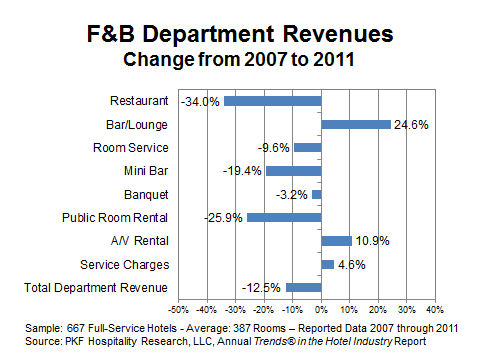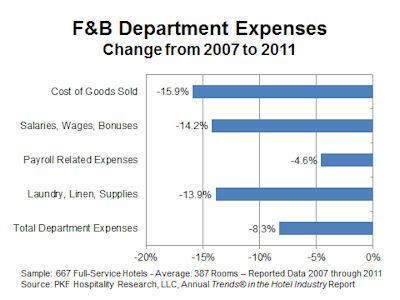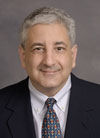Presentations, Service Charges, and Booze
Recent Trends in Hotel Food & Beverage
|
News for the Hospitality Executive |
Presentations, Service Charges, and Booze
|
By
Robert Mandelbaum
December 18, 2012 PKF Hospitality Research LLC (PKF-HR), along with most industry participants, has been pleasantly surprised by the strong rebound in lodging demand that has occurred since the depths of the great recession in 2009. While a lot has been written about the positive impact this has had on rooms revenue, we would like to take this time to analyze the performance of the second largest source of revenue for full-service hotels – food and beverage. To understand recent trends in hotel food and beverage (F&B), PKF-HR studied the financial performance of hotel restaurants, lounges, room-service, and catering departments for the period 2007 through 2011. The information came from a same-store sample of 667 full-service, convention, and resort hotel operating statements taken from PKF-HR's Trends® in the Hotel Industry database. In 2011, the hotels in the sample averaged 387 rooms in size, 71.2 percent in occupancy, and an ADR of $163.78. Revenue Still Down Like rooms revenue, unit-level hotel food and beverage department revenues are still below pre-recession levels. In 2011, the properties in our sample averaged $22,959 per available room (PAR) in F&B revenue. Despite enjoying a cumulative 11.5 percent jump in F&B revenue that past two years, this still puts the sample properties 12.5 percent below the F&B sales volume these same hotels achieved in 2007. For reference purposes, the hotels in our research sample are 10.1 percent behind 2007 rooms revenue levels, and 11.4 percent short in total revenue. Accordingly, F&B revenue at the sample properties averaged just 24.5 percent of total hotel revenue in 2011, down from 27.9 percent in 2007. 
While guests are spending less in the restaurant, they appear to be drowning their sorrows in the lounge. Hotel bar sales for the sample are up 24.6 percent from 2007 to 2011. Other revenue sources that have “recovered” since 2007 are A/V rental (+10.9%) and service charges (+4.6%). These last two sources of revenue tend to be less negotiable with event planners. Expenses and Profits While food and beverage revenues have declined since 2007 peak levels, F&B managers appear to have built back the department flow-through. During the depths of the recession, F&B department profit margins declined from 29.7 percent in 2008 to 26.5 percent in 2009. Since then, the department profit margin has bounced back to 29.8 percent in 2011.   Fortunately, most of the big expense items in the F&B department are highly variable in nature. As expected, with lower volumes of business, hotel chefs are spending less on the raw food and beverage products they purchase. The cost of goods sold within the F&B departments of our survey sample declined by 15.9 percent from 2007 to 2011. Labor expenses, the other “prime cost” within the F&B departments, also declined by 11.3 percent during the same period. However, it should be noted that the controllable portion of labor costs (salaries, wages, and bonuses) were cut by 14.2 percent, but the less controllable portion (employee benefits) were reduced by just 4.6 percent. Despite effectively managing expenses, F&B profit levels have declined by 23.2 percent from 2007 to 2011. The average property in our sample averaged a food and beverage department profit of $4,919 PAR in 2011, down from $6,404 PAR in 2007. Consistent with proper hotel accounting, F&B department profits are calculated before deductions for administrative, marketing, maintenance, and utility expenses. Innovation Hotel owners have been fortunate that the economic factors that have the greatest influence on lodging demand have grown and pushed guests through the front door. However, once inside the property, managers continue to struggle to maximize guest expenditures in other areas of the hotel. Dining trends are more volatile than lodging trends. Recognizing this, hotel managers have made some significant changes in the way they offer food and beverage service to their guests. The traditional three-meal, all-purpose restaurant is disappearing. Taking their place are self-service kiosks that provide quick-service for in-house guests, or upscale, celebrity chef restaurants designed to attract local patrons. Food and beverage managers need to continue to be innovative in the future, both in terms of generating revenue and controlling expenses.  Robert Mandelbaum is Director of Research Information Services for PKF Hospitality Research, LLC (www.pkfc.com). He works in the firm's Atlanta office. To learn about the tools PKF-HR offers to benchmark the performance of hotel F&B operations, please visit www.pkfc.com/benchmarker. This article was published in the November 2012 edition of Lodging. |
| Contact:
Robert Mandelbaum |